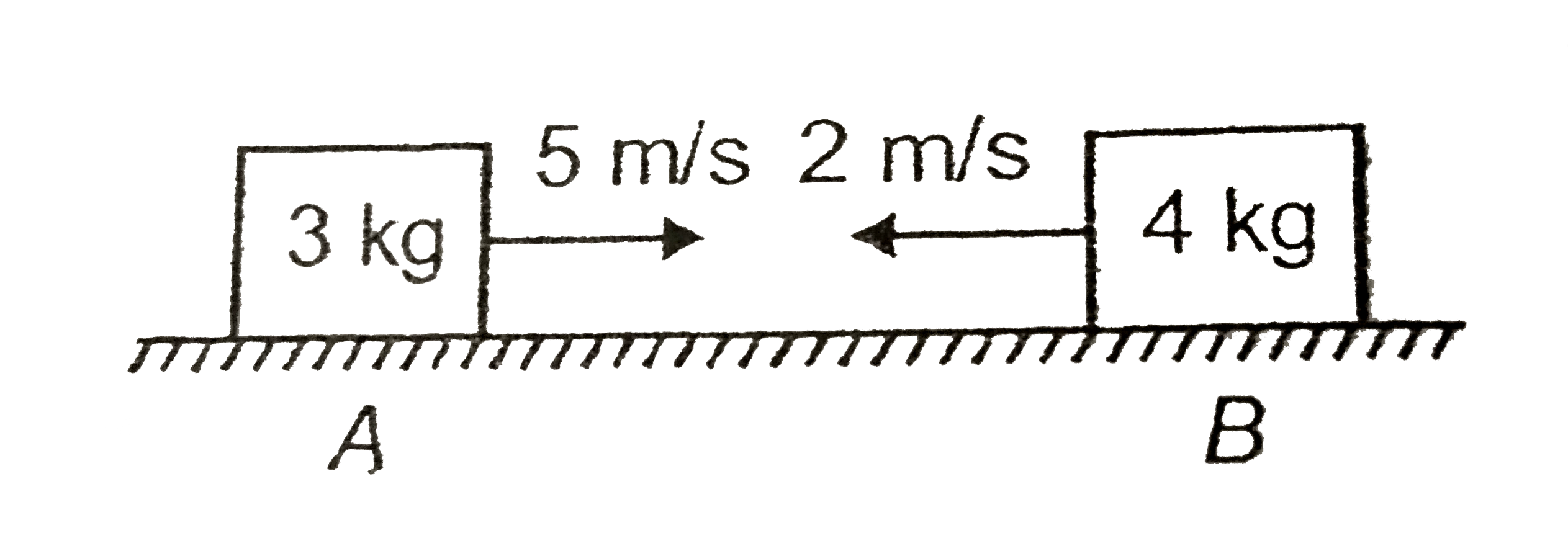Two bodies, each having a mass of 3kg, collide with each other. One body was at rest and the other was moving with a 4m⋅s−1 velocity. After collision they combine with each other. Find out the heat produced as a result of this collision. Mechanical equivalent of heat = 4.2J⋅cal−1.Solution in Bengali
The correct Answer is:2.86 cal
Step by step video, text & image solution for Two bodies, each having a mass of 3kg, collide with each other. One body was at rest and the other was moving with a 4 m cdot s^(-1) velocity. After collision they combine with each other. Find out the heat produced as a result of this collision. Mechanical equivalent of heat = 4.2 J cdot cal^(-1). by Physics experts to help you in doubts & scoring excellent marks in Class 11 exams.
Topper's Solved these Questions
- BOOK - CHHAYA PUBLICATIONCHAPTER - FIRST AND SECOND LAW OF THERMODYNAMICSEXERCISE - Entrance Corner - Assertion-reason type4videos
FIRST AND SECOND LAW OF THERMODYNAMICS
- BOOK - CHHAYA PUBLICATIONCHAPTER - FIRST AND SECOND LAW OF THERMODYNAMICSEXERCISE - Entrance Corner - Multiple correct answer type1videos
FIRST AND SECOND LAW OF THERMODYNAMICS
- BOOK - CHHAYA PUBLICATIONCHAPTER - FIRST AND SECOND LAW OF THERMODYNAMICSEXERCISE - Exercise - Problem Set - II (Marks 3 or 4)33videos
FIRST AND SECOND LAW OF THERMODYNAMICS
- BOOK - CHHAYA PUBLICATIONCHAPTER - EXPANSION OF SOLIDS AND LIQUIDSEXERCISE - CBSE SCANNER2videos
EXPANSION OF SOLIDS AND LIQUIDS
- BOOK - CHHAYA PUBLICATIONCHAPTER - FRICTION EXERCISE - CBSE SCANNER7videos
FRICTION
Similar Questions
Statement I : In an isothermal process the whole heat energy supplied to the body is converted into internal energy.
Statement II : According to the first law of thermodynamics ΔQ=ΔU+pΔV.11:31View SolutionCvandCp denote the molar specific heat capacities of a gas at constant volume and constant volume and constant pressure, respectively. Then,
02:05View SolutionThe temperature of a hailstone is 0∘C and initially it is at rest. When it falls from a height, 160the part of it melts. Calculate the height, Ignore the air resistance and assume that the temperature of the surroundings is 0∘C. When it hits the ground, only 15th of its stored energy is converted into heat.
04:36View SolutionShow that the coefficient of superficial expansion of a rectangular sheet of the solid is twice its coefficient of linear expansion.
04:00View SolutionDefine angle of friction. The inclination θ of a rough plane is increased gradually. The ply on the plane just comes into motion when inclination θ becomes 30∘. Find coefficient of friction. If the inclination is further increased to 45∘ then find acceleration of the body along the plane. (g = 10 m.s−2)
09:19View SolutionA body of mass m makes an elastic collision with another identical body at rest. Show that if the collisionis not head on the bodiese to at right to each other after the collision.
05:10View SolutionTwo bodies move towards each other and collide inelastically. The velocity of the first body is 2 m//s and that of the seconf is 4m//sec before impact. The common velocity after collision is 1 m//s in the direction of the first body. The number of times did the KE of the first body exceed that of the second body before collision.
03:08View SolutionTwo bodies of mass m_(1) = 1kg and m_(2) = 2kg move towards each other in mutually perpendicular directions at velocities v_(1) = 3m//s and v_(2) = 2m//s (Fig). As a result of collision, the bodies stick together. Determine the amount of heat Q liberated as a result of collisions.
05:45View SolutionTwo bodies of masses 0.1 kg and 0.4 kg move towards each other with the velocities 1 m/s and 0.1 m/s respectively, After collision they stick together. In 10 sec the combined mass travels
05:22View SolutionTwo particles A and B of mass 3kg and 4kg moving on a smooth horizontal surface with speed 5m/s and 2m/s respectively collides each other. Coefficient of restitution is e=12, then

Velocity of B after collision03:24View SolutionTwo balls are moving towards each other on a vertical line collides with each other as shown. Find their velocities just after collision.
04:45View SolutionA body (A) of mass 100 g and another body (B) of mass 400 g approach each other with velocities of 100 cm⋅s−1and10cm⋅s−1 respectively. After a head on collision, the bodies coalesce. After collision, find the displacement of the combined mass in 10 s .
04:25View SolutionTwo particles of equal mass moving towards each other with velocities 20 m*s^(-1) and 30 m*s^(-1) collide. If the collision is elastic, find their velocities after the collision.
04:20View SolutionTwo bodies of masses 5 kg and 10 kg move towards each other with velocities 10m⋅s−1and14m⋅s−1 respectively. If the coefficient of restitution is 0.8, find their velocities after the collision.
View SolutionA body of mass 2 kg is pulled with a velocity 2m⋅s−1 on horizontal surface. What will be the heat produced in 5s, if the coefficient of friction between the body and the surface is 0.2? Given, J=4.2J⋅cal−1,g=9.8m⋅s−2.
04:24View Solution

